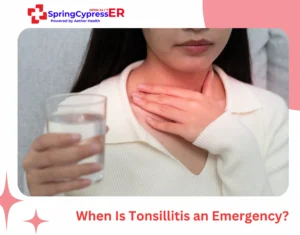Many people wonder when is tonsillitis an emergency and when it’s just another sore throat. While most cases are mild and improve on their own, tonsillitis can sometimes turn into a serious condition that threatens your breathing or overall health.
So let’s understand what tonsillitis is and when you should seek emergency care.
What Is Tonsillitis?

Tonsillitis is the inflammation of the tonsils, which are two oval-shaped pads of tissue located at the back of the throat. As part of the immune system, the tonsils help trap and fight bacteria and viruses that enter through the mouth. Sometimes, however, they become infected and inflamed themselves.
Most cases are viral, similar to a common cold, and usually resolve within a week. Bacterial tonsillitis, often caused by Streptococcus pyogenes (the same bacteria responsible for strep throat), may require antibiotics to prevent complications and reduce the risk of severe tonsillitis.
To avoid confusion, here’s a clear breakdown of Tonsillitis vs Strep Throat.
When Is Tonsillitis an Emergency: 6 Symptoms You Should Never Ignore
In some cases, tonsillitis can progress beyond a simple infection and cause serious complications. Here are the red flags:
1. Difficulty Breathing or Swallowing
Severe swelling of the tonsils or the surrounding tissues can block the airway. If you notice gasping, labored breathing, or an inability to swallow saliva, it’s time to head to the emergency room (ER). This can be life-threatening.
2. Signs of a Peritonsillar Abscess (Quinsy)
A peritonsillar abscess is a serious complication of untreated or severe tonsillitis. This occurs when pus collects near the tonsils, leading to:
- Severe, one-sided throat pain
- Difficulty opening the mouth (trismus)
- Muffled or hot potato voice
- Swelling on one side of the throat
A peritonsillar abscess can spread infection to deeper tissues and the bloodstream if not treated quickly.
3. High, Persistent Fever
While a mild fever is common with tonsillitis, a fever above 102°F (39°C) that does not respond to medications may signal a more dangerous infection that requires urgent medical evaluation.
4. Severe Dehydration
Tonsillitis can make swallowing painful, leading some people (especially children) to refuse food and fluids. If dehydration develops (dry mouth, no tears, dark urine, dizziness), it can become an emergency.
5. Spreading Infection
If tonsillitis bacteria spread beyond the throat to the lymph nodes, chest, or bloodstream, the infection can cause sepsis, a life-threatening condition. Warning signs include rapid heart rate, confusion, extreme weakness, or bluish skin.
6. Recurrent or Chronic Tonsillitis
Multiple severe episodes of tonsillitis per year may weaken the immune system and raise the risk of complications. In such cases, ENT specialists may recommend tonsillectomy (surgical removal of the tonsils).
Common Symptoms of Tonsillitis
Not every case of tonsillitis is an emergency. Most infections cause symptoms that are uncomfortable but not life-threatening, such as:
- Sore throat and painful swallowing
- Red, swollen tonsils (sometimes with white patches or pus)
- Fever and chills
- Swollen lymph nodes in the neck
- Bad breath or unpleasant taste in the mouth
- Hoarseness or muffled voice
These symptoms usually improve within 7 to 10 days, especially if the cause is viral. However, if they linger, worsen, or overlap with the red-flag signs described earlier, the condition may have progressed to severe tonsillitis that requires medical attention.
Tonsillitis Complications to Know
If not treated properly, tonsillitis complications can be severe. Some of the most concerning include:
- Peritonsillar abscess: As mentioned above, a pus-filled infection requiring drainage.
- Sleep apnea: Enlarged tonsils may block the airway during sleep, causing breathing pauses, snoring, and fatigue.
- Post streptococcal complications: Untreated bacterial tonsillitis (strep) can lead to rheumatic fever, kidney inflammation (post streptococcal glomerulonephritis), or scarlet fever.
- Systemic infection (sepsis): Bacteria spreading from the tonsils to the bloodstream is rare but life-threatening.
Recognizing when is tonsillitis an emergency early ensures timely medical care and reduces long-term health risks.
When to Go to the ER for Tonsillitis

If you are unsure whether your symptoms require emergency care, use these guidelines: Go to the ER for tonsillitis if you experience:
- Difficulty breathing, swallowing, or speaking
- Severe or one-sided throat pain with swelling
- Inability to open your mouth (trismus)
- High fever unresponsive to medication
- Signs of dehydration or refusal to drink fluids (common in children)
- Confusion, drowsiness, or fainting
Even if you are not sure, it’s always safer to seek urgent medical advice rather than wait.
Treatment Options for Severe Tonsillitis

Treatment depends on the cause and severity of the condition. Options may include:
- Antibiotics: Prescribed when bacterial infection is confirmed (such as strep throat). It is important to complete the full course to prevent recurrence or complications.
- IV fluids: For patients unable to swallow or at risk of dehydration.
- Drainage procedures: A peritonsillar abscess may need to be drained surgically by an ENT Specialist.
- Tonsillectomy: Recommended for recurrent or chronic tonsillitis, or when complications arise.
- Supportive care: Pain relievers, fever reducers, hydration, and rest.
Home Care for Mild Tonsillitis
While mild cases are not emergencies, self-care can speed recovery and relieve discomfort. Some tips include:
- Drinking plenty of fluids to stay hydrated
- Gargling with warm salt water several times a day
- Using throat lozenges or sprays for pain relief
- Taking acetaminophen or ibuprofen for fever and soreness
- Using a humidifier to ease throat dryness
However, if symptoms last beyond a week or worsen, seek medical advice promptly.
Final Thoughts
Tonsillitis is common and usually harmless, but severe tonsillitis is not. It’s important to recognize when is tonsillitis an emergency.
If you or someone you love experience breathing troubles, a persistent high fever, or dehydration, head to the nearest emergency room.
At Spring Cypress ER, we’re available with 24/7 on-the-spot lab testing and IV medications to quickly diagnose the severity of your tonsillitis and treat it before it becomes life-threatening.
FAQs
1: Can tonsillitis go away on its own?
Yes, many cases caused by viruses improve within a week without antibiotics. But bacterial infections may require medical treatment.
2: How do I know if my child’s tonsillitis is serious?
If your child refuses fluids, has difficulty breathing, or develops a high fever, take them to the ER immediately.
3: What happens if tonsillitis is left untreated?
Untreated bacterial tonsillitis can lead to rheumatic fever, kidney damage, or abscess formation.
4: Can recurrent tonsillitis be prevented?
Practicing good hygiene, avoiding close contact with infected individuals, and considering a tonsillectomy if recommended by a doctor can help.
5: Is tonsillectomy always necessary?
No, it’s usually reserved for recurrent, chronic, or severe tonsillitis with complications.




